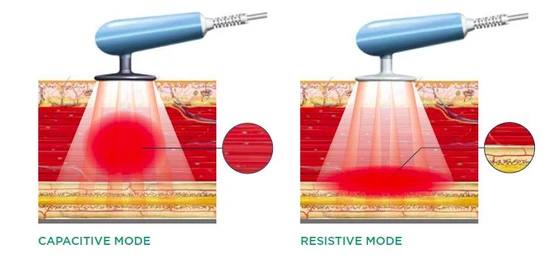TECARTHERAPY Capenergy
The use of heat as a treatment for various conditions has been known for many years: it provides relief from chronic, traumatic and inflammatory conditions, increases blood flow by improving cellular nutrition and oxygenation, and speeds up the elimination of toxins; improves the elasticity of connective tissue, reduces joint stiffness, muscle pain and spasm, and promotes the absorption of haematomas and oedemas.
Use of tecarterapy:
The application of an electric field with the appropriate power, frequency and waveform characteristics to energise tissues, thus restoring chemical/electrical balance... This is the theory that justifies its use in physiotherapy. Each cell is involved in the regenerative function of tissue through morphological and chemical-electrical interactions.
The thermal action on an inflamed or damaged area frees up space before the mechanical action, allowing a longer treatment duration and deeper application.

Capacitive or resistive?
"Impedance in medicine is a characteristic of any tissue that allows current to pass through it"
How many times in Tecarterapy have we decided to use the capacitive (448kHz) or resistive (750kHz) method for the same treatment because we were not sure which to choose?
Many companies, (perhaps too many), recommend a 10 minute capacitive treatment as well as a 10 minute resistive treatment with greater pain relief.
We need to be clear about something! The electric current we are talking about goes around the body and releases more energy into areas where there are large impedance changes. More specifically, this happens at the interface of high and low impedance, where more energy is released (for example, between bones and soft tissue).
The current will always take the less difficult path (low impedance), so it will never pass through the bone, but will release energy on the outside - according to the principles indicated earlier. In assimilating this concept, it is easy to understand the difference between resistive and capacitive.
A resistive is a non-insulated metal electrode that can release energy where it encounters an impedance difference. If the electrode is below the surface, a high-impedance tissue (such as bone or a large tendon) can be identified immediately, and much of the energy is better distributed over the surface; if, on the other hand, the difference between high and low impedance is identified at greater depth, more attention must be paid to the path of the current. This current path is determined by the position between the plate and the electrode. From this it is immediately clear that resistance is necessary to work well with geometries.
